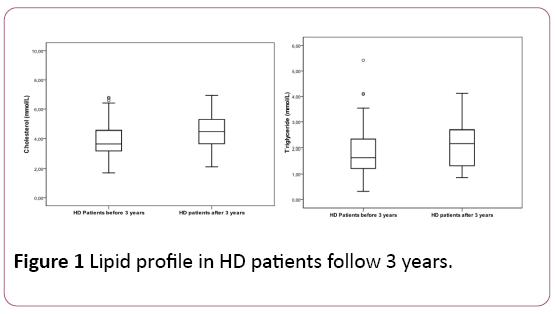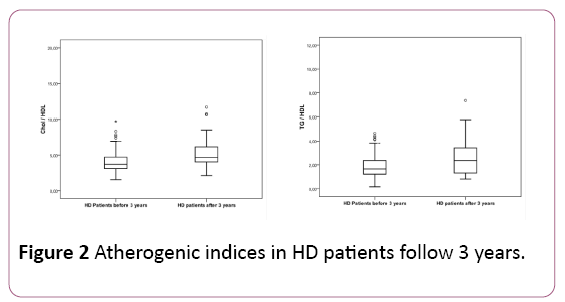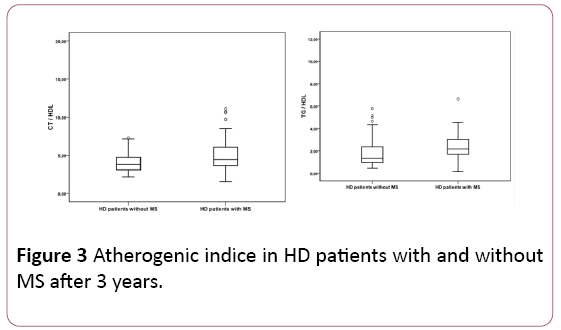Kerkeni Mohsen1*, Hammami Mohamed1, Ben Omrane Sioud Olfa1, Knani Ines1, El-Ati Zohra2, Machfar Hanen2 and Bouzidi Hassan3
1Faculty of Medicine, Laboratory of Biochemistry, University of Monastir, Tunisia
2Department of Nephrology and Dialysis; Hospital-Tahar Sfar, Mahdia, Tunisia
3Laboratory of Biochemistry, Hospital-Tahar Sfar, Mahdia, Tunisia
Corresponding Author:
Kerkeni Mohsen
Faculty of Medicine, Laboratory of Biochemistry, University of Monastir, Tunisia
Tel: +216 73 462 853
E-mail: mohsen.kerkeni@yahoo.fr
Received Date: January 12, 2018; Accepted Date: January 25, 2018; Published Date: January 29, 2018
Citation: Mohsen K, Mohamed H, Olfa BOS, Ines K, Zohra EA, et al. (2018) Prevalence of Metabolic Syndrome in Hemodialysis Patients Follow- Up for Three Years: Relationship with Cardiovascular Disease Development. Biochem Mol Biol J Vol.4: No.1: 3. DOI: 10.21767/2471-8084.100052
Keywords
Metabolic syndrome; Cardiovascular disease; Hemodialysis
Introduction
Chronic kidney disease (CKD), and mostly, the end stage renal disease (ESRD) are subject to further studies because there is worldwide public health problem [1]. Patients with the ESRD have in increased risk for the development of many diseases: anemia, malnutrition, oxidative stress [2] and cardiovascular diseases (CVD). CVD are the crucial cause of morbidity and mortality in CKD patients [3,4]. Mostly, those patients die from CVD than progressing to ESRD [5]. In accordance, Herzog and coworkers indicate that before attain the end stage 30% of CKD patients have shown signs of heart failure or ischemic heart disease[6]. In ESRD, patients are systematically using hemodialysis treatment (HD). At this stage, cardiovascular complications are common [7]. The association of CVD and HD are receiving increased attention to prevent and treat complications occurred.
However, the major indicators of CVD recognized are metabolic syndrome (MS). MS is considered as an interconnected physiological, clinical, biochemical and metabolic disorder that characterized by hypertriglyceridemia, central abdominal obesity, high blood pressure (BP), low highdensity lipoprotein (HDL) cholesterol levels and high fasting blood glucose levels [8,9]. Although, CVD are increased with the presence of MS [8,10]. Multiply by three according to the work of Delarue et al. [11]. Indeed, risk of CVD are 38% higher in patients with MS than patients without MS [7]. Many studies confirm a positive correlation between MS, CVD and CKD [7,12-14]. There has been very little study interesting to this correlation for HD patients. In our study, we focused on this specific population for a better understanding relation between hemodialysis, cardiovascular complications and MS.
The prevalence of MS depends on many factors, such as the definition of MS used, country, urban or rural environment, and composition of the population studied (sex, age). It is ranged from 30% to much as 84% worldwide [9,11]. However, in the literature few data are interesting in the prevalence of MS in HD patients follow up some years. The purpose of the present study is, firstly, to estimate lipid profile and atherogenic indices (cholesterol/HDL, triglycerides/HDL) in HD patients with or without MS and secondly, to evaluate the relationship between the prevalence of MS and the presence of cardiovascular disease in HD patients through three years later.
Materials and Methods
Study population
A study was conducted at hemodialysis department in CHU Taher Sfar in Mahdia (Tunisia). A total of 200 participants were included; 100 patients with end stage renal diseases receiving regular hemodialysis treatment (three times per week for 4 hours) and 100 healthy volunteers. Consent of all participants was obtained before inclusion in this study. We excluded patients provisory hemodialysis, less than 6 months in HD, under than 18 years old and having serious comorbidities or malignancy. Hemodialysis treatment was performed until a low-flux dialyser (Fresenius Medical Care, Germany) with a polysulfone membrane (surface area of 1.4 m2, Fresenius Medical Care). The dialysate and the blood flow rate were respectively 500 mL/min and 250-300 mL/min. Heparin was used for anticoagulation. All patients had an arteriovenous fistula. The definition of MS used was elaborated by the National Cholesterol Education Program Adults Treatment Panel III (NCEP-ATPIII) [15]. After three years, among the one hundred hemodialysis patients only 43 patients were present in the final cohort studied.
Data collection
A meticulous interrogatory was prepared to collect different information such as: personal and medical history, family antecedent, demographic characteristics, physical activities and lifestyle risk factors. According to the recommendations of the World Health Organization (WHO), physical activities were categorized into sedentary lifestyle for patient's physically inactive, healthy and non-healthy physical activity for patients who respectively meet or not recommendations [16]. Before starting dialysis session and with heavy clothing, anthropometric measurements including height, body weight and waist circumference were measured. The waist circumference was measured horizontally at the central point between the iliac crest and the costal margin. Body mass index (BMI) was calculated and classified into obese (≥ 30 kg/m²), overweight (25-29 kg/m²), healthy weight (18.5-24 kg/m²) and underweight (<18.5 kg/m²) [16]. After 15 min in sitting position, the average of two measurements of blood pressure was made. Systolic blood pressure (SBP) and diastolic blood pressure (DBP) were expressed. For healthy control and in pre- HD period for HD patients, a fasting venous blood samples was collected to investigate: Total cholesterol (mg/dl), triglyceride (mg/dl), hight-density lipoprotein (HDL) (mg/dl), low-density lipoprotein (LDL) (mg/dl). Through the ratios CT/HDL and TG/ HDL, the atherogenic index was calculated. All those tests were performed in the biochemical laboratory of our hospital using standards methods.
Statistical analysis
Statistical Package for the Social Sciences (SPSS Software, version 21) for windows was used for all the data analysis. Data were expressed as the percentage, the mean and standard deviation (SD). Different comparisons between groups of HD patients with MS and without MS were performed using Student's t-test and χ² test, according to statistical significance at P<0.05.
Results
Clinical characteristic of the study population
The clinical characteristics and demographic data of the study population are shown in Table 1. The two groups were appeared in age. The mean age of HD patients was 54 ± 17 years and the most age distribution in both male and female was in age between 60 and 74 years.
| Variables |
HD patients
(n=100) |
Control subjects
(n=100) |
| Age (years) |
54 ± 17 |
52 ± 9 |
| Female (%) |
38 |
41 |
| Diabetes (%) |
18 |
- |
| Hypertension (%) |
73 |
- |
| Dyslipidemia (%) |
55 |
- |
| Smoking (%) |
41 |
- |
| BMI (kg/m2) |
24.5 ± 4. 8 |
23.82 ± 2.7 |
| MS (%) |
46 |
- |
| CVD (%) |
43 |
- |
| Data represent means ± SD or percentages. |
| BMI: Body Mass Index; MS: Metabolic Syndrome; CVD: Cardiovascular Disease |
Table 1: Demographic and clinical characteristics of study population.
The HD patients showed 18% diabetic, 55% dyslipidemia and 73% hypertension. 43% of HD patients present a cardiovascular disease. According to the NCEP-ATPIII criteria, it was found that 46% of participants had MS. Association of all components of MS was finding in 6% of population study, 13% having four components of the metabolic syndrome and 27% of HD patients have assembled three different components.
Lipid profile and atherogenic in studied population
The lipid profile and atherogenic index of the study population were shown in Table 2. According to our results, we found statistically significant difference between levels of TG, TC, HDL, LDL and atherogenic index between the HD patients and control subjects.
| Parameters |
HD patients
(n=100) |
Control subjects
(n=100) |
P |
| Triglyceride (mmol/L) |
1.84 ± 0.93 |
1.08 ± 0.51 |
<0.001 |
| Total cholesterol (mmol/L) |
3.94 ± 1.23 |
4.55 ± 0.73 |
<0.001 |
| HDL cholesterol (mmol/L) |
1 ± 0.33 |
1.31 ± 0.33 |
<0.001 |
| LDL cholesterol (mmol/L) |
2.11 ± 1.1 |
2.8 ± 0.72 |
<0.001 |
| CT/HDL |
4.33 ± 2.19 |
3.68 ± 1.1 |
0.012 |
| TG/HDL |
2.11 ± 1.52 |
0.91 ± 0.68 |
<0.001 |
| The values are expressed as means ± SD; TG:Triglycerides; CT: Total Cholesterol; HDL-cholesterol: High Density Lipoprotein Cholesterol; LDL-cholesterol: Low Density Lipoprotein Cholesterol |
Table 2: Lipid profile and atherogenic index of study population.
Lipid profile and atherogenic index in HD patients follow 3 years
The lipid profile in HD patients before and after 3 years is shown in Figure 1. The median (interquartile range) of cholesterol and triglyceride levels were increased after 3 years (P<0.01, P<0.001; respectively).

Figure 1: Lipid profile in HD patients follow 3 years.
In addition, the atherogenic index in HD patients before and after 3 years is shown in Figure 2. The median (interquartile range) of cholesterol/HDL and triglyceride/HDL levels were increased after 3 years (P<0.01, P<0.001; respectively).

Figure 2: Atherogenic indices in HD patients follow 3 years.
Atherogenic index in HD patients with and without MS after 3 years
After 3 years, HD patients with MS showed an increased median (interquartile range) of cholesterol/HDL and triglyceride/HDL levels compared to HD patients without MS (P<0.01, P<0.001; respectively), as illustrated in Figure 3.

Figure 3: Atherogenic indice in HD patients with and without MS after 3 years.
Lipid profile and atherogenic index in HD patients with and without CVD fallow 3 years
HD patients with cardiovascular disease showed a significant increased level of TC, TG and atherogenic index after three years. Detailed parameters are shown in Table 3.
| Variables |
Without CVD |
With CVD |
| Before |
After 3years |
Before |
After 3years |
| TC (mmol/L) |
3.9 ± 1 |
4.2 ± 1.2a |
3.9± 1.4 |
4.6 ± 1.1a |
| TG (mmol/L) |
1.8 ± 0.9 |
2 ± 0.7a |
1.8 ± 0.9 |
2.2 ± 0.9a |
| HDL (mmol/L) |
1 ± 0.3 |
0.9 ± 0.2 |
0.9 ± 0.3 |
0.8 ± 0.2 |
| LDL (mmol/L) |
2 ± 0.8 |
1.2 ± 0.9 |
2.1 ± 1.3 |
1.5 ± 1 |
| TC/HDL |
3.9 ± 1.5 |
4.9 ± 1.9b |
4.7 ± 2.7 |
5.8 ± 2.8b |
| TG/HDL |
2 ± 1.3 |
2.5 ± 1.2b |
2.2 ± 1.6b |
3 ± 2.4b |
| a<0.01; b<0.001 |
Table 3: Lipid profile and atherogenic index in HD patients with and without CVD fallow 3 years.
Patients with MS for three-year follow-up have an increased prevalence for cardiovascular disease compared to patients without MS (43% to 56%; P<0.01).
Discussion
Cardiovascular diseases are the major cause of morbidity and mortality in the End Stage Renal Disease. Many studies associate the metabolic syndrome with ESRD. In fact, this association multiplies risks of CVD [17,18]. The main finding of our study was that the prevalence of the metabolic syndrome in our hemodialysis patients was 46% defined according to the NCEP-ATPIII criteria. It's on accordance with study of Maoujoud O et al. finding 44% [3]. In literature, the prevalence of MS in hemodialysis patients was very different, it's ranged from 23% to up then 60% [3,19-21]. Differences depend, specially, in definition of MS used.
In present study, we found a significant increase in lipid profile and atherogenic index in HD patients with MS compared to HD patients without MS. The increased levels of these parameters were markedly observed follow three years. Many studies confirmed that, the lipid profile on hemodialysis patients was classically characterized by a high predominance of hypertriglyceridemia, hypo-HDL cholesterol and a high atherogenic index [13,17].
In addition, we found that HD patients with MS have an important increase in CVD. We found a significant increase in lipid profile and atherogenic index in HD patients with CVD compared to HD patients without CVD. The increased levels of these parameters were markedly observed follow three years. We found a significant relationship between parameters linked to MS and CVD (P<0.01). This association between MS and CVD is largely studied and approved. In fact, for HD patients MS was considered as an independent predictor of cardiovascular events [4]. After three years follow-up, the lipid profile and atherogenic index in HD patients were increased, and HD patients with SM develop a cardiovascular disease compared to HD patients without SM. Followed up three years, study of Wu and coworkers include 91 HD patients confirm our results. Patients with MS (defined by the International Diabetes Federation) had a significant higher risk of cardiovascular events [22,23].
Conclusion
For three years follow-up, we showed a significant increase of lipid profile and atherogenic index in HD patients, that may increase prevalence of MS and increased the risk of cardiovascular disease.
References
- Boini S, Leplege A, Loos C, Français P, Ecosse E, et al (2007)Mesure de la qualité de vie dans l ’ insuffisancerénalechroniqueterminale.NephrolTher3:372-383.
- Liakopoulos V, Roumeliotis S, Gorny X, Dounousi E, Mertens PR (2017) Oxidative stress in hemodialysis patients?: A review of the literature.Oxid Med Cell Longev3081856.
- Maoujoud O, Ahid S, Asseraji M, Bahadi A, Aatif T, et al. (2011) Prévalence du syndrome métabolique chez les hémodialyséschroniques au Maroc. East Mediterr Heal J 17:56-61.
- de José AP, Verdalles-Guzmán Ú, Abad S, Vega A, Reque J, et al. (2014) Metabolic syndrome is associated with cardiovascular events in haemodialysis. Nefrologia 34:69-75.
- Suresh H, Arun BS, Venkatesh M, Mallikarjuna S (2017) Cardiorenal syndrome type 4: A study of cardiovascular diseases in chronic kidney disease. Indian Heart J 69:11-16.
- Herzog CA, Ma JZ, Collins AJ(1998) Poor long-term survival after acute myocardial infarction among patients on long-term dialysis. N Engl J Med 339:799-805.
- Tu SF, Chou YC, Sun CA, Hsueh SC, Yang T (2012) The prevalence of metabolic syndrome and factors associated with quality of dialysis among hemodialysis patients in Southern Taiwan. Glob J Health Sci 4:53-62.
- Thomas G, Sehgal AR, Kashyap SR, Srinivas TR, Kirwan JP, et al. (2011) Metabolic syndrome and kidney disease: A systematic review and meta-analysis. Clin J Am SocNephrol 6:2364-2373.
- Kaur J(2017) A comprehensive review on metabolic syndrome. Cardiol Res Pract.
- Isomaa B, Almgren P, Tuomi T, Forsén B, Lahti K, et al. (2001) Cardiovascular morbidity and mortality associated with the metabolic syndrome. Diabetes Care 24:683-689.
- Delarue J, Allain G, Guillerm S (2006)Le syndrome métabolique. NutrClinMetab 2006;20:114-117.
- Ming J, Xu S, Yang C, Gao B, Wan Y, et al. (2014) clinicachimica acta metabolic syndrome and chronic kidney disease in general Chinese adults?: Results from the 2007-08 China National Diabetes and Metabolic Disorders Study. ClinChim Acta 430:115-120.
- Alakkas Z, Alswat KA, Otaibi MA, Althobaiti T, Alzaidi N, et al.(2015) The prevalence and the clinical characteristics of metabolic syndrome patients admitted to the cardiac care unit. J Saudi Hear Assoc 28:136-143.
- Chen J, Dongfeng G, Chung-Shiuan C, Xigui W, Lee H, et al. (2014) Association between the metabolic syndrome and chronic kidney disease in Chinese adults. Int J ClinExp Med 7: 4448-4454.
- Expert Panel on detection, evaluation, and treatment of high blood cholesterol in Adults (2001) Executive summary of the third report of the national cholesterol Education Program (NCEP) expert panel on detection, evaluation, and treatment of high blood cholesterol in adults (adult treatment panel III). J Am Med Assoc285:2486-2497.
- The World Health Report (2002)?Reducing risks, promoting healthy life. World Health Organization, Geneva, Switzerland.
- Prasad GR(2014) Metabolic syndrome and chronic kidney disease: Current status and future directions. World J Nephrol 3:210.
- Kessler M(2000) Athérosclérose et hémodialyse session III 21:349-350.
- Benkacimi N, Fedala S, Mokhtar M(2013)Undefined Le syndrome métaboliqueenhémodialysechronique(étude descriptive). Elsevier edn.
- Tsangalis G, Papaconstantinou S, Kosmadakis G, Valis D, Zerefos N (2007) Prevalence of the metabolic syndrome in hemodialysis. Int J Artif Organs 30:118-123.
- Protack CD, Jain A, Vasilas P, Dardik A (2012) The influence of metabolic syndrome on hemodialysis access patency. J VascSurg 56:1656-1662.
- Djibril MAOS (2015) Lipid profile of hemodialysis patients at the CHU sylvanusOlympio in Togo. Intern Med Open Access 5:2-5.
- Wu CC, Liou HH, Su PF, Chang MY, Wang HH, et al. (2011) Abdominal obesity is the most significant metabolic syndrome component predictive of cardiovascular events in chronic hemodialysis patients. Nephrol Dial Transplant 26:3689-3695.




